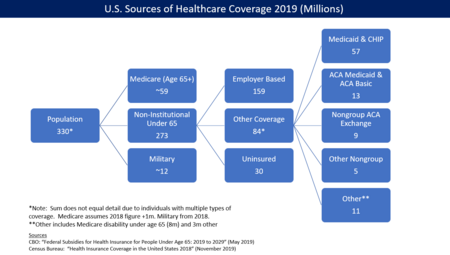What Does How Much Is The Health Care Penalty Mean?
Several single-payer state referendums and bills from state legislatures have actually been proposed, however with the exception of Vermont, all have failed. In December 2014, Vermont canceled its prepare for single-payer healthcare. California tried passage of a single-payer costs as early as 1994, and the first successful passages of legislation through the California State Legislature, SB 840 or "The California Universal Health Care Act" (authored by Sheila Kuehl), occurred in 2006 and again in 2008.

State Senator Mark Leno has reestablished the expense in each legal session considering that. On February 17, 2017, SB 562, which is likewise called "The Healthy California Act" was presented to the California State Senate. This expense is a $400 billion strategy that was sponsored by the California Nurses Association to carry out single-payer health care in California.

Under this proposed bill, all California citizens will be covered in the Healthy California Act SB 562 no matter their migration status. This costs will likewise include transient students that attend California institutions whom, bought their health care program through the school. Solutions that will be covered by this expense will need to figure out as medically necessary by the client's picked healthcare company.
SB 562 passed in the State Senate on June 1, 2017 with a vote of 23-14. When the expense was sent to the State Assembly, it was put on hold by Assembly Speaker Anthony Rendon, who revealed issue over financing. Although the expense was postponed, there are hopes it will be revived so it can be reviewed once again by both the State Senate and State Assembly.
Getting My Which Of The Following Is True About The Health Care Latinos Receive? To Work
According to SB-562, a Healthy California Trust Fund would be developed to provide financing for the expense. Presently, states receive funding from the federal government for particular healthcare services such as Medicaid and Medicare. In addition to taxes, these funds would be pooled into the brand-new trust fund and provide the sources of moneying needed to implement The Healthy California Act.
The Colorado State Health Care System Effort, Change 69, was a citizen-initiated constitutional modification proposal in November 2016 to vote on a single-payer healthcare system moneyed by a 10% payroll tax split 2:1 in between companies and employees. This would have changed the private medical insurance premiums presently paid by staff members and companies.
In 2009, the Hawaii state legislature passed a single-payer healthcare bill that was vetoed by Republican Governor Linda Lingle. While the veto was bypassed by the legislature, the expense was not carried out. In 2007, the Health Care for All Illinois Act was introduced and the Illinois Home of Representatives' Health Availability Gain access to Committee passed the single-payer bill favorably out of committee by an 84 vote. who is eligible for care within the veterans health administration?.
Massachusetts had passed a universal health care program in 1986, but spending plan restraints and partisan control of the legislature resulted in its repeal prior to the legislation could be enacted. Concern 4, a nonbinding referendum, was on the ballot in 14 state districts in November 2010, asking citizens," [S] hall the representative from this district be advised to support legislation that would establish healthcare as a human right regardless of age, state Home page of health or employment status, by developing a single payer medical insurance system like Medicare that is comprehensive, cost reliable, and publicly supplied to all citizens of Massachusetts?" The tally concern passed in all 14 districts that provided the concern.
An Unbiased View of Which Level Of Health Care Provider May Make The Decision To Apply Physical Restraints To A Client?
The expense was lost consciousness of both the Senate Health Real Estate and Household Security Committee and the Senate Commerce and Consumer Security Committee in 2009, but your house version was eventually tabled. In 2010, the expense passed the Senate Judiciary Committee on a voice vote as well as the Home Health Care & Human Being Services Policy and Oversight Committee.
It has been introduced once again in the 2013 session in both chambers. In September 2011, Governor Brian Schweitzer revealed his objective to seek a waiver from the federal government enabling Montana to set up a single-payer health care system. Guv Schweitzer was not able to implement single-payer healthcare in Montana, but did make relocate to open government-run clinics, and in his final spending plan as guv, increased coverage for lower-income Montana citizens.
The New York Health Act passed the Assembly four times: as soon as in 1992 and again in 2015, 2016, and 2017, but has not yet advanced through the Senate after referrals to the Health Committee. On all events, the legislation passed the Assembly by an almost two-to-one ratio of support. when it comes to health care. The state of Oregon tried to pass single-payer health care by means of Oregon Ballot Measure 23 in 2002, and the measure was rejected by a considerable majority.
In December 2014, Vermont canceled its prepare for single-payer healthcare. Vermont passed legislation in 2011 developing Green Mountain Care. When Governor Peter Shumlin signed the bill into law, Vermont ended up being the first state to functionally have a single-payer health care system. While the costs is thought http://judahyelf554.raidersfanteamshop.com/about-how-was-the-medicare-pps-system-designed-to-curb-escalating-health-care-costs about a single-payer expense, personal insurance companies can continue to run in the state forever, suggesting it Go to the website does not fit the stringent definition of single-payer (which of the following is a trend in modern health care across industrialized nations?).
The Health Care Sector Constituted What Percentage Of The U.s. Gross Domestic Product In 2014? Fundamentals Explained
Advocates for single-payer healthcare mention assistance in polls, although the polling is mixed depending upon how the question is asked. Surveys from Harvard University in 1988, the Los Angeles Times in 1990, and the Wall Street Journal in 1991 all showed strong assistance for a healthcare system comparable to the system in Canada.
A 2007 Yahoo/AP poll showed 54% of respondents considered themselves advocates of "single-payer health care," and 49% of respondents in a 2009 poll for Time Magazine revealed support for "a national single-payer strategy similar to Medicare for all." Polls by Rasmussen Reports in 2011 and 2012 revealed 49% opposed to single-payer health care.
A majority of Democratic Celebration voters support Medicare for all. Physicians for a National Health Program, National Nurses United, the American Medical Trainee Association, Healthcare-NOW!, and the California Nurses Association are amongst advocacy groups that have called for the intro of a single-payer health care program in the United States. A 2007 study released in the discovered that 59% of physicians "supported legislation to develop national medical insurance" while 9% were neutral on the topic, and 32% opposed it.
Diagnostic tests defined as the following: non-emergency magnetic resonance imaging (MRI) gadgets; calculated tomography (CT or FELINE) scans; and angiographies that use X-rays to examine the inner opening of blood-filled structures such as veins and arteries. Gaffney, Adam (September 16, 2018). Universal healthcare was unimaginable in America, but not any more. The Guardian.
Excitement About How Does Electronic Health Records Improve Patient Care
" single-payer system meaning". September 23, 2017. Archived from the initial on October 2, 2017. Obtained December 12, 2017. " the meaning of single-payer". Dictionary. com. Archived from the initial on August 2, 2017. Obtained December 12, 2017. " What We Talk About When We Talk About Single Payer". healthaffairs. org. Archived from the initial on October 22, 2017.
" What is single-payer healthcare?". March 26, 2014. Archived from the initial on October 22, 2017. Recovered December 12, 2017. Medical Subject Headings thesaurus, National Library of Medication." Single-Payer System" Archived March 4, 2016, at the Wayback Maker Year presented: 1996, (From Slee and Slee, Healthcare Reform Terms, 1993, p.
